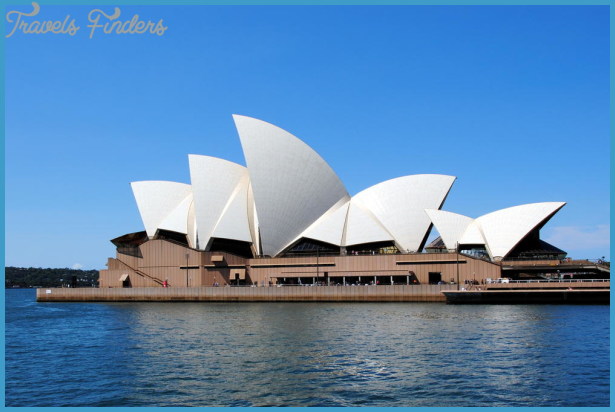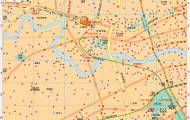1957-73 OPERA HOUSE SYDNEY, AUSTRALIA
J0RN UTZON
In 1956 the government of New
South Wales, Australia, announced an international competition to design a new opera house for Sydney. The site was Benelong Point, a promontory with views to the sea and the famous Harbour Bridge. Many architects submitted proposals, and the winner was J0rn Utzon, a Danish architect little known outside his home country.
Utzon’s design incorporated a series of sculptural white roofs that swept up from near the ground, like the billowing sails of the yachts on the water beyond. It was undoubtedly the stunning form of these roofs, which covered the building’s two main halls, that won Utzon the competition, but they also posed a major problem: Utzon’s competition designs had been created without input from structural engineers and did not give enough information to work out exactly what shape the roofs should be.
As a result of the ensuing technical problems, controversies about aspects of the design, and disputes over the budget, the construction of the Opera House was dogged by problems from the start. Work began in 1959 with the design of the roofs still unresolved. Utzon and the structural engineers,
Ove Arup and Partners, eventually worked out that the best solution would be to treat the roofs like the sections of a sphere. The concrete structure finally began to rise, but Utzon resigned when the project was put under the control of the Ministry of Public Works and there was a political dispute over control of the work.
After Utzon’s resignation the layout of the building’s interior was altered to make it more practical. In spite of all the difficulties a stunning building had emerged by the time construction ended, and the Opera House is now a world-class performing arts center.
The billowing roofline has become not only a celebrated icon of post-war architecture but also a symbol of the modern, vibrant city of Sydney.
J0RN UTZON
1918-2008
The architect of the Sydney Opera House was born in Copenhagen, Denmark. Before setting up his own office in his home city, Utzon worked for the great Swedish architect Gunnar Apslund and spent a year with the influential Finnish modernist Alvar Aalto. He designed houses in Denmark until he won the Sydney competition in 1957. The Opera House became his most famous building, but the controversy surrounding its construction and the huge cost overrun (arguably caused by politicians setting an artificially low budget) meant that few high-profile clients commissioned him. After Sydney, Utzon returned to Europe and designed a memorable church at Bagsvsrd, Copenhagen, and the National Assembly Building in Kuwait. Both buildings showed his flair for creating sculptural architecture using concrete.
Visual tour
The larger auditorium was originally intended for staging operas, but is now used as a concert hall
Glass walls provide views across the harbor
Opera House
1 EXTERIOR STEPS The imposing approach to the Opera House is up a broad flight of granite steps and across an outside podium to the foyers. These are, therefore, well above ground level, and the service rooms are concealed beneath them.
3 ROOF TILES Chevron-shaped trays containing thousands of white ceramic tiles cover the roofs. Some of the tiles are glazed, while others have a matte finish, and the contrast between the two produces a striking pattern of light and shade across the sculptural roofs.
The service rooms are situated under the auditoria and foyers
1 ROOF SHELLS The shape of the roofs was inspired by the sails of boats J0rn Utzon enjoyed sailing. Their distinctive profile arching segments standing out against the sky has made the Opera House the most recognizable building in Australia and has given it iconic status.
1 ENTRANCES Visitors enter the Opera House through soaring walls of glass, giving uninterrupted views into the impressive foyers of the twin auditoria. Vertical steel mullions hold the huge sheets of glass in place and anchor the windows directly to the precast concrete structure of the roofs.
A small shell-roofed structure houses the restaurant
ON CONSTRUCTION
Because Utzon’s original competition design was short on detail and because the competition brief itself was somewhat unspecific the design of the Opera House went through many alterations after Utzon won. Both architect and engineers tried to find a way of working out the geometry of the roofs, trying ellipses, parabolas, and other shapes, before they decided on sections of a sphere. Making the transition from the roofs to the floor was also a major challenge. Utzon achieved this at either end of the building with great walls of glass, which he referred to as glass curtains.
He also redesigned the hall interiors several times, but their final appearance owes most to the team that took over after his resignation.
Working models
Utzon and the engineers made numerous cardboard and wooden models of the building to help them with aspects of the design such as the curtains of glass (left) and the structural ribs for the roof (right).
1 CONCERT HALL INTERIOR Banks of seating for almost 2,700 people look toward the stage and the organ pipes beyond in this large space originally intended for opera productions. The high, vaulted ceilings are clad in curving panels of plywood and the simple, elegant seat backs in a pale birch veneer.
IN CONTEXT
In the early part of the 20th century, architects realized that concrete was a material with outstanding sculptural properties. Curves and other unusual shapes that took hard work and skill to achieve in brick or stone could be created relatively easily using concrete. Expressionist architects exploited the malleability of the material in the 1920s and 1930s, and after the end of World War II architects again began to sculpt rounded shapes using concrete.
As well as curving walls, concrete reinforced with steel could be used to create thin-shell structures, as in the roof of the TWA Flight Center, New York, designed by Eero Saarinen, a Finnish architect who was on the judging panel for the Sydney Opera House competition. J0rn Utzon was very much a man of his time in his expressive use of concrete shells.
1 GLASS SCREENS Huge upward-sweeping canopies of glass cover the foyers and bars at the northern end of the building. Each screen consists of a three-layer sandwich of glass held in place by ribs of steel. Utzon is said to have based the design on a bird’s wing.
1 TAPESTRY In 1993 Utzon was invited to offer guidance on refurbishing the interiors of the Opera House. In 2004 the Reception Hall, now known as the Utzon Hall, was completed and a stunning, 46ft- (14m-) wide, full-length tapestry, designed by the architect, was hung on the wall opposite the harbor outlook.
1 TWA Flight Center, New York, 1962
The outstretched, winglike roofs of Eero Saarinen’s building form an obvious symbol for flight. Inside, the concrete structure houses a series of fluid spaces.
















